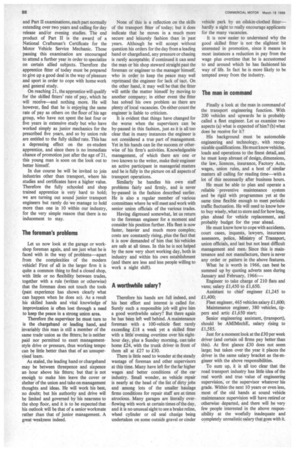The foreman's problems Let us now look at the garage
Page 90

If you've noticed an error in this article please click here to report it so we can fix it.
or workshop foreman again, and see just what he is faced with in the way of problems—apart from the complexities of the modern vehicle! First of all in the larger firm it is quite a common thing to find a closed shop, with little or no flexibility between trades, together with a rule (written or otherwise) that the foreman does not touch the tools (past experience has shown clearly what can happen when he does so). As a result his skilled hands and vital knowledge of improvization is often lost through a need to keep the peace in a strong union area.
Therefore the supervisor he must turn to is the chargehand or leading hand, and invariably this man is still a member of the same trade union as the fitters; he is neither paid nor permitted to exert managementstyle drive or pressure, thus working tempo can be little better than that of an unsupervised team.
As stated, the leading hand or chargehand may be between threepence and sixpence an hour above his fitters; but that is not enough to make him leave the cover or shelter of the union and take on management thoughts and ideas. He will work his best, no doubt; but his authority and drive will be limited and governed by his nearness to the shop• floor, and it is to be expected that his outlook will be that of a senior workmate rather than that of junior management. A great' weakness indeed. None of this is a reflection on the skills of the transport fitter of today; but it does indicate that he moves in a much more secure and leisurely fashion than in past years. Although he will accept without question his orders for the day from a leading hand or chargeliand, any pressure or chasing is rarely acceptable; if continued it can send the man or his shop steward straight past the foreman or engineer to the manager himself, who in order to keep the peace may well reprimand the engineer for lack of tact. On the other hand, it may well be that the fitter will settle the matter himself by moving to another company; in either event the fitter has solved his own problem as there are plenty of local vacancies. On either count the engineer is liable to criticism.
It is evident that things have changed for the worse when the supervisors can be by-passed in this fashion, just as it is all too clear that in many instances the engineer is not considered a true part of management. Yet in his hands can lie the success or otherwise of his firm's activities. Knowledgeable management, of which there are one or two known to the writer, make their engineer an active participant in managerial matters and he is fully in the picture on all aspects of transport operations.
Similarly he handles his own staff problems fairly and firmly, and is never by-passed in the fashion described earlier. He is also a regular member of various committees where he will meet and work with senior union officials of the various trades.
Having digressed somewhat, let us return to the foreman engineer for a moment and consider his position further. His fleet is now faster, heavier and much more complex; costs are constantly rising, plus the fact that it is now demanded of him that his vehicles are safe at all times. In this he is not helped by the now very short working day, both in industry and within his own establishment (and there are less and less people willing to work a night shift).




































































































































































